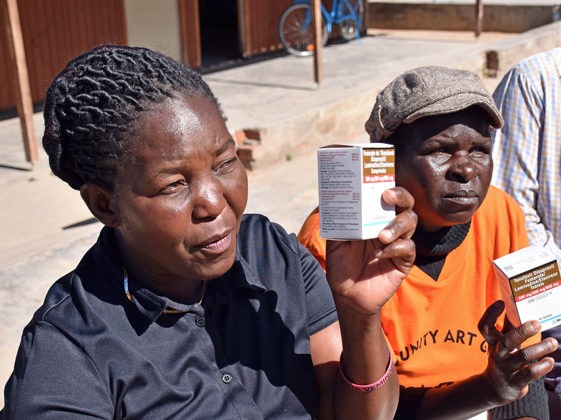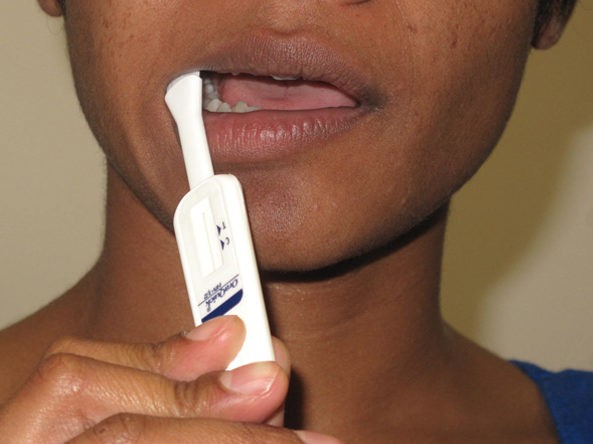Article and Study Summary
Lopinavir plus nucleoside reverse-transcriptase inhibitors, lopinavir plus raltegravir, or lopinavir monotherapy for second-line treatment of HIV (EARNEST): 144-week follow-up results from a randomised controlled trial.
Published in:
Lancet Infect Dis. 2017. [Epub ahead of print] http://dx.doi.org/10.1016/S1473-3099(17)30630-8
Authors:
Hakim JG, Thompson J, Kityo C, et al. for the Europe Africa Research Network for Evaluation of Second-line Therapy (EARNEST) Trial Team.
Summary:
The Europe Africa Research Network for Evaluation of Second-line Therapy (EARNEST) trial is a randomized, open-label clinical trial that compared the efficacy and safety of three second-line antiretroviral therapy (ART) regimens after 144 weeks of follow-up. The study enrolled adults and adolescents at 14 sites in five sub-Saharan African countries, who were no longer responding to first-line ART. Participants were randomized to receive second-line treatment with either boosted lopinavir (LPV/r) plus two or more nucleoside reverse-transcriptase inhibitors (NRTIs), LPV/r plus raltegravir (RAL), or LPV/r monotherapy. The study found that there were no long-term efficacy or safety benefits of LPV/r plus RAL, compared to LPV/r plus NRTIs, which remains the standard of care for second-line therapy in resource-limited settings. The LPV/r plus RAL regimen did not meet the non-inferiority criterion for the primary outcome of viral load <400 copies per milliliter at 144 weeks, which differed from previous results reported after 96 weeks of follow-up. Additionally, this trial demonstrated that despite high levels of resistance to NRTIs at baseline, LPV/r plus NRTIs was still an effective second-line regimen.
Download full synopsis here or read below.
Discussion Questions:
- How might the data presented in this study inform processes for switching people to second-line ART in your country?
- Given the WHO’s public health approach to ART, what are the implications of the finding that NRTIs remained effective in second-line regimens, despite high levels of resistance at baseline?
Please share your thoughts and experiences with us in the comments section below.
Full Synopsis:
Study Summary
The Europe Africa Research Network for Evaluation of Second-line Therapy (EARNEST) trial is a randomized, open-label trial that compared the long-term efficacy of a protease inhibitor (PI) with two or more nucleoside reverse-transcriptase inhibitors (NRTIs), a PI with raltegravir (an integrase inhibitor), or PI monotherapy as second-line antiretroviral therapy (ART) in adolescents and adults who were no longer responding to a non-NRTI-based first-line regimen.
Study Setting
- Fourteen study sites in Uganda, Zimbabwe, Malawi, Kenya, and Zambia
Methods
- HIV-infected adults and adolescents older than 12 years of age who were no longer responding to a first-line ART combination of NRTIs with a non-NRTI were enrolled between April 2010 and April 2011.
- Criteria for first-line treatment failure were based on WHO guidelines from 2010, which included clinical, immunological or virological criteria (1), and all cases were confirmed to have a viral load >400 copies per milliliter.
- Participants were excluded if they were pregnant or breastfeeding, had a life expectancy of less than one month, had contradictions to any of the study drugs, were expected to be on medication that was known to interact with study drugs, or were known to have a positive hepatitis B surface antigen.
- Participants were randomly assigned (1:1:1) to one of three second-line regimens, stratified by center and screening CD4 count (above or below 200 cells per microliter), and were followed for 144 weeks.
- The three second-line regimens all consisted of a boosted PI (lopinavir 400 milligrams/ritonavir 100 milligrams [LPV/r] twice daily), plus two or more NRTIs (selected by physicians without resistance testing based on local guidelines, following WHO algorithms), plus raltegravir (RAL) 400 milligrams twice daily, or alone as monotherapy (following RAL induction for the first 12 weeks).
- In May 2013, the data monitoring committee recommended switching participants in the PI monotherapy group to combination therapy, due to poorer viral load suppression and more PI resistance than in the PI plus NRTI group.
- Participants were assessed for clinical response and adherence every four to eight weeks, predominantly by nurses; CD4 count was measured every 12-16 weeks; and full blood count, alanine transaminase, serum creatinine, and urine dipstick test for glucose, protein, and leucocytes were done at weeks 12, 48, 96, and 144.
- Real-time viral load monitoring was not done routinely, but stored samples from weeks 4, 12, 24, 36, 48, 64, 80, 96, 110, 126, and 144 were tested centrally by staff blinded to group allocation.
- Genotype testing was done blinded at baseline and for all post-randomization samples with a viral load >1000 copies per milliliter.
- Within-class ART substitutions were allowed for toxicity or poor tolerability, and clinical or immunologic failure could be investigated with viral load and genotype testing, with treatment changes as needed depending on local regimen availability.
- The primary outcome was viral load <400 copies per milliliter at week 144.
- Secondary outcomes at week 144 included: viral load <50 copies per milliliter, viral load <1000 copies per milliliter, intermediate or high level of LPV resistance, good disease control (composite endpoint), survival, WHO stage 4 events, CD4 count >250 cells per microliter, CD4 count change from baseline, serious adverse events, grade 3 or 4 adverse events, and change in neurocognitive function from baseline.
- All analyses were by intention to treat.
Study Population and Follow-up
- A total of 1,837 participants were screened for eligibility and 1,277 were randomized, with 426 assigned to PI plus NRTI, 433 to PI plus RAL, and 418 to PI monotherapy.
- At baseline median viral load was 69,782 copies per milliliter (42% had viral load >100,000 copies per milliliter), and median CD4 count was 71 cells per microliter (62% had CD4 count <100 cells per microliter), with no differences by study arm.
- Ninety-eight percent of the 787 participants with genotype results at baseline had one or more major NRTI mutations.
- Seventy-nine percent of the participants in the PI plus NRTI group received tenofovir plus lamivudine or emtricitabine in their initial second-line regimen.
- At 144 weeks, 8% of participants had died, 2% had withdrawn or were lost to follow-up, and 1% had switched ART due to treatment failure.
Primary Outcome: Viral Load <400 copies per milliliter
- In a complete-case analysis at 144 weeks (excluding death, lost to follow-up and missing viral load), 86% of participants in the PI plus NRTI group had viral load <400 copies per milliliter, compared to 81% in the PI plus RAL group and 78% in the PI monotherapy group (p=0.01).
- The outcome in the PI plus RAL group was not significantly different from that in the PI plus NRTI group, but this did not meet the pre-specified non-inferiority criterion of -10% (difference -4.9% , 95% confidence interval [CI] -10.2 to 0.3; p=0.07).
- PI plus RAL did not show superiority compared to PI plus NRTI in any subgroup, and failed to meet the non-inferiority criterion in many subgroups.
Secondary Clinical Outcomes
- At 144 weeks, a viral load <50 copies per milliliter was found in 75%, 72%, and 66% of participants in the PI plus NRTI group, PI plus RAL group, and PI monotherapy group, respectively, and a viral load <1000 copies per millliliter in 87%, 84%, and 80% of participants, respectively.
- Intermediate or high-level resistance to LPV/r was found in 2% of the PI plus NRTIgroup, 3% of the PI plus RAL group, and 11% of the PI monotherapy group.
- Intermediate or high-level resistance to one or more NRTIs taken during the trial was found in 3% of the PI plus NRTI group, and intermediate or high-level resistance to RAL was found in 7% of the PI plus RAL group.
- There was no significant difference between the groups in good disease control (composite endpoint), survival, WHO stage 4 events, CD4 count >250 cells per microliter, or CD4 count change from baseline.
Secondary Safety Outcomes
- An adverse event resulting in ART modification occurred in 6% of the PI plus NRTIgroup, 5% of the PI plus RAL group, and 3% of the PI monotherapy group (p=0.06).
- There were no significant differences between the groups in serious adverse events, grade 3 or 4 events, symptomatic peripheral neuropathy, or changes in renal function, hemoglobin or neurocognitive function from baseline.
Critical Analysis
This study found that there were no long-term efficacy or safety benefits of PI plus RAL as second-line ART, compared to PI plus NRTIs, the current standard of care in resource-limited settings. Although there was no statistically significant difference in the efficacy of the two regimens, inferiority of the PI plus RAL regimen could not be ruled out. This study also demonstrated the lack of efficacy of PI monotherapy. Surprisingly, virologic response in the PI plus NRTI group was not impaired by the extensive NRTI resistance present at baseline.
The following points should be considered when interpreting the study findings:
- This is the largest randomized controlled trial evaluating PI plus RAL as second-line therapy, with the longest follow-up period. Earlier findings from this trial after 96 weeks of follow-up demonstrated non-inferiority of the PI plus RAL regimen.
- The trial employed the WHO’s public health approach, using clinical, immunological or virological criteria for treatment failure, without resistance testing, and used procedures appropriate for resource-limited settings, such as delivery of care by nurses and infrequent laboratory monitoring.
- The results may not be generalizable to higher-resource settings in which decisions about second-line treatment can be more individualized and informed by genotype results.
- This trial selected a viral load of <400 copies per milliliter as the primary endpoint, which is different from the WHO treatment failure threshold of 1000 copies per milliliter and the target for viral suppression of <50 copies per milliliter. This endpoint was chosen because it would be less affected by transient low-level viremia, while still being considered clinically significant. The PI plus RAL regimen did meet the non-inferiority criterion using these alternative viral load thresholds.
- At the time of the trial, routine viral load monitoring was not available to clinicians, and thus they were unable to provide enhanced adherence counseling for those with an elevated viral load.
- In this trial, tenofovir was used in the majority of second-line regimens in the PI plus NRTI group, but now it is commonly used as part of a first-line regimen in many settings.
- Since the study began in 2010, the integrase inhibitor dolutegravir has been approved, which has a higher genetic barrier to resistance and a longer half-life than RAL, allowing for once daily dosing.
- This study was open-label, and therefore participants and clinicians were not blinded to group allocation. However the primary outcome of viral load was an objective measure and blinded to treatment group.
Implications
The EARNEST trial evaluated the efficacy and safety of second-line ART regimens in resource-limited settings, and after 144 weeks of follow-up found no advantage to a boosted PI with RAL over a boosted PI with two or more NRTIs. The study findings support the current WHO treatment guidelines, which recommend a boosted PI with two NRTIs as the preferred second-line regimen. (2) However the guidelines also list LPV/r plus RAL as an alternative second-line regimen in adults and adolescents. While initial results from this trial after 96 weeks of follow-up suggested an equivalence between these regimens, the long-term results reported in this paper are more equivocal and cannot exclude the possibility that LPV/r plus RAL is an inferior regimen. This study also showed that despite high levels of resistance to NRTIs at baseline, LPV/r plus NRTIs was still effective. This suggests that routine genotype resistance testing after first-line treatment failure may be of limited value, especially in resource-limited settings.
References
- World Health Organization. Antiretroviral therapy for HIV infection in adults and adolescents. Recommendations for a public health approach: 2010 revision. Geneva: World Health Organization, 2010.
- World Health Organization. Consolidated guidelines on the use of antiretroviral drugs for treating and preventing HIV infection: recommendations for a public health approach. Geneva: World Health Organization, 2016.









